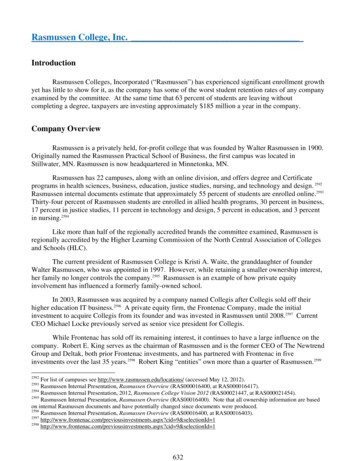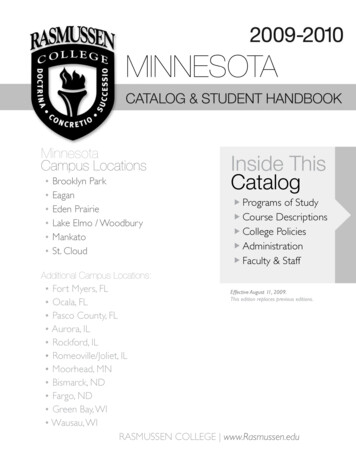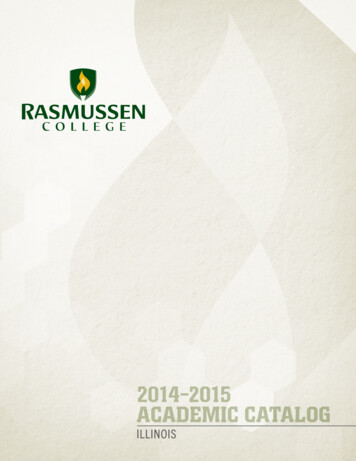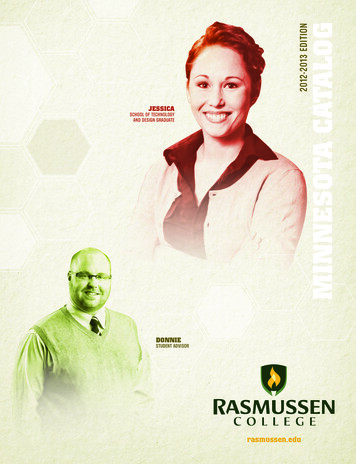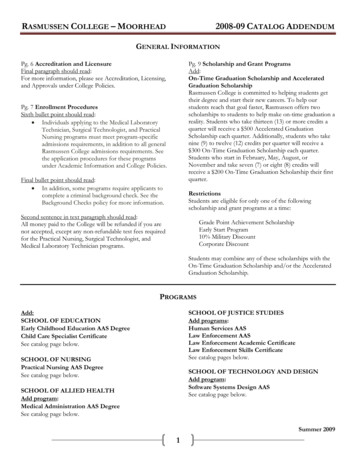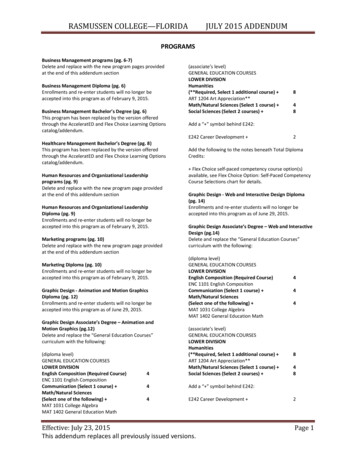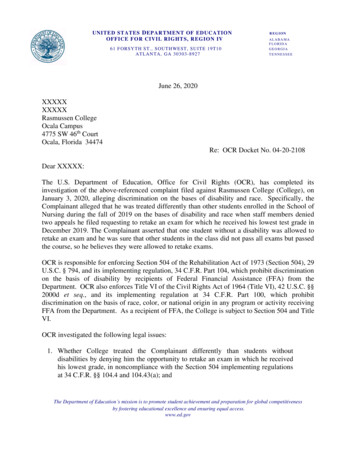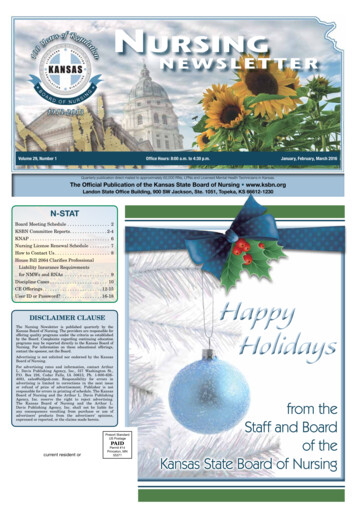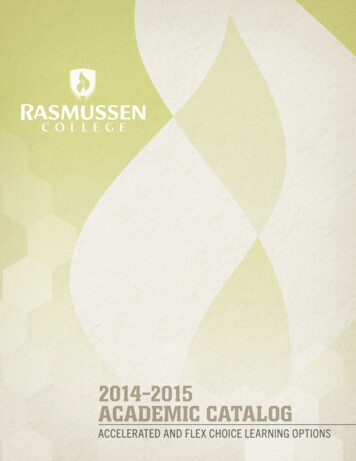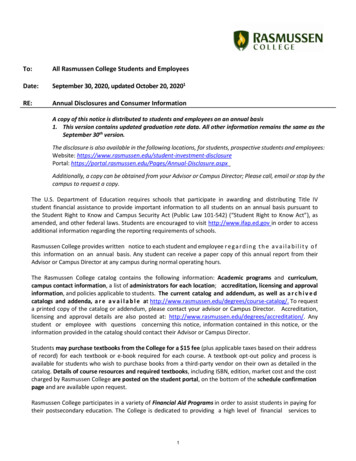
Transcription
To:All Rasmussen College Students and EmployeesDate:September 30, 2020, updated October 20, 20201RE:Annual Disclosures and Consumer InformationA copy of this notice is distributed to students and employees on an annual basis1. This version contains updated graduation rate data. All other information remains the same as theSeptember 30th version.The disclosure is also available in the following locations, for students, prospective students and employees:Website: osurePortal: re.aspxAdditionally, a copy can be obtained from your Advisor or Campus Director; Please call, email or stop by thecampus to request a copy.The U.S. Department of Education requires schools that participate in awarding and distributing Title IVstudent financial assistance to provide important information to all students on an annual basis pursuant tothe Student Right to Know and Campus Security Act (Public Law 101-542) (“Student Right to Know Act”), asamended, and other federal laws. Students are encouraged to visit http://www.ifap.ed.gov in order to accessadditional information regarding the reporting requirements of schools.Rasmussen College provides written notice to each student and employee r e g a r d i n g t h e a v a i l a b i l i t y o fthis information on an annual basis. Any student can receive a paper copy of this annual report from theirAdvisor or Campus Director at any campus during normal operating hours.The Rasmussen College catalog contains the following information: Academic programs and curriculum,campus contact information, a list of administrators for each location; accreditation, licensing and approvalinformation, and policies applicable to students. The current catalog and addendum, as well as a r c h i v e dcatalogs and addenda, a r e a v a i l a b l e at http://www.rasmussen.edu/degrees/course-catalog/. To requesta printed copy of the catalog or addendum, please contact your advisor or Campus Director. Accreditation,licensing and approval details are also posted at: http://www.rasmussen.edu/degrees/accreditation/. Anystudent or employee with questions concerning this notice, information contained in this notice, or theinformation provided in the catalog should contact their Advisor or Campus Director.Students may purchase textbooks from the College for a 15 fee (plus applicable taxes based on their addressof record) for each textbook or e-book required for each course. A textbook opt-out policy and process isavailable for students who wish to purchase books from a third-party vendor on their own as detailed in thecatalog. Details of course resources and required textbooks, including ISBN, edition, market cost and the costcharged by Rasmussen College are posted on the student portal, on the bottom of the schedule confirmationpage and are available upon request.Rasmussen College participates in a variety of Financial Aid Programs in order to assist students in paying fortheir postsecondary education. The College is dedicated to providing a high level of financial services to1
students while also complying with all state and federal requirements. The College maintains information foryour convenience on the following pages: Financial Aid Student Information Guide: http://guides.rasmussen.edu/fa Tuition Estimator: http://www.rasmussen.edu/tuition/ Net Price Calculator: https://npc.collegeboard.org/student/app/rasmussen FinancialAidInfo Military Education Benefits Guide: its/ Student Loans, Grants, And Discounts: nts/ (pleasenote all four tabs on the page) Financial Aid Resources: http://www.rasmussen.edu/tuition/financial-aid/The pages specified above, along with the Rasmussen College catalog, specifically the “Primary Sources of FinancialAid and How to Apply” section, contain important information regarding the financial aid process at RasmussenCollege and the resources available to help you make informed decisions about financing your education,including details of grants and scholarship programs, assistance and steps in applying for federal financial aidvia the Free Application for Federal Student Aid (FAFSA). We encourage students should check the catalog andweb pages regularly, as policies and procedures are reviewed and updated to with the latest information.Admissions staff, Advisors and Student Financial Aid staff are available to answer questions and provideinformation regarding the College, programs, policies and Financial Aid availability for those who qualify.The College has a professionally staffed Student Financial Aid department designed to help students apply forfederal, state, and private assistance. The primary purpose of financial aid is to help students who otherwisewould not be able to attend a post-secondary institution to meet the cost of higher education. The basicresponsibility for financing your education lies with the student and their family. Aid is based upondocumented financial need — the difference between the cost of college and the student’s ability to pay for it.Potential costs include books, tuition, supplies, room and board, transportation, living expenses, and child carecosts. There are three basic types of aid available to Rasmussen College students: Various state and federal student loan programs. Gift Aid, also known as grants, is assistance you do not have to pay back and is usually based uponfinancial need. Employment through work study programs may provide relevant work experience and decrease thenecessity of borrowing student loans for living expenses.If a student wishes to withdraw, they need to notify their Advisor, Campus Director or Dean to initiate the“change of school status” process, which initiates the withdrawal and the Return to Title IV Funds process.Students are allowed to convey their withdrawal verbally or in writing via email. The change of school statusand return to title IV funds processes are initiated when a student is expelled. Information regardinginstitutional adjustments of tuition upon withdrawal, including the required federal refund calculation requiredfor all students who withdraw prior to attendance and completion of 60% of the term are found in theRasmussen College catalog at hile a postsecondary degree is required for many professions, completion of a Rasmussen College degreeprogram does not guarantee employment in any profession. Prior to enrollment, students are responsible toaffirm and be comfortable with the education, training, experience and licensing requirements for employmentin their chosen field. Several degree programs require passing a background check and/or completion of2
required vaccinations to be eligible for enrollment. The Rasmussen College catalog contains a complete listof programs, entrance requirements, tuition/fee details, institutional licensing and complete policies suchas transfer of credit, background checks, immunizations, and standards of satisfactory academic progress(SAP). Current and archived catalogs, along with catalog addenda are available upon request on campus, viayour advisor and Campus Director as well as online at: n addition to residing in the catalog, the current tuition structure sheet which lists all tuition rates and fees isincluded in each student’s enrollment agreement.The careers our programs are designed to prepare students for are listed on the page for each program inthe Rasmussen College catalog. While we monitor the outcomes of our graduates for purposes of helping ouracademic leaders assess the quality of our programs, we do not publish rates for individual programs unlessrequired to by a programmatic accreditor. For programs where that requirement exists, we publish rates onthe applicable program page of our website. We encourage you to review the information posted on ourwebsite, as well as data published by federal agencies about Rasmussen College including the d.ed.gov.Graduation Rates at Rasmussen College are reported to federal agencies by state. The following rates are the mostrecent disclosures provided under the Student Right to Know Act:FloridaIllinoisMinnesotaNorth DakotaWisconsinKansas28%22%34%37%26%16%Graduation Rate CalculationThe rates above are based on a calculation that includes only “full-time, first-time” students who enrolled atRasmussen College in 2013. This cohort is measured at 6 years to determine the percentages shown asspecified in federal regulations.Students who have previously attended another postsecondary institution, or who began their studies on apart-time basis are excluded from this rate. At Rasmussen College, a small percentage of students, as few as15%, are considered "full-time, first-time" for purposes of calculating the rates shown above.For a d d i t i o n a l d e t a i l s , i n cluding s t u d e n t b o d y d i v e r s i t y , r etention rates and graduationrates broken down by gender as well as racial/ethnic groups, please see the information provided below,and visit the U.S. Department of Education’s National Center for Education Statistics College Navigator athttps://nces.ed.gov/collegenavigator/. Outcome measures, including details of degree/certificate-seekingundergraduate students who are part-time attending and non-first-time students, and for students receivingPell grants and for those not receiving Pell grants can be found in our listings on the Navigator.Undergraduate Student Attendance StatusFull-TimePart-Time354%46%
Undergraduate Student Age24 and under25 and over25%75%Undergraduate Student GenderMenWomen14%86%Undergraduate Student Body DiversityHispanic/LatinoAmerican Indian or Alaska NativeAsianBlack or African AmericanNative Hawaiian or Other Pacific IslanderWhiteTwo or more racesRace and ethnicity unknown11%1%3%19%0%44%3%19%For information regarding Rasmussen College program costs, required credits and program length, pleasesee the Rasmussen College Catalog at www.rasmussen.edu/degrees/course-catalog, our tuition estimator atwww.rasmussen.edu/tuition, or our net price calculator sen.Clery ActThe Jeanne Clery Disclosure of Campus Security Policy and Campus Crime Statistics Act, originally known asthe Campus Security Act, mandates that colleges and universities disclose information about certain categories ofcrimes that are committed on and around their campuses. The Clery Act, enacted by Congress and signed into lawby President George Bush in 1990, was championed by Howard & Connie Clery after their daughter Jeanne wasmurdered at Lehigh University in 1986.Campus Security and Awareness is a top priority at Rasmussen College. As part of the campus crimeprevention plan, the institution provides staff and faculty training in the prevention of crime, sexualharassment/violence and alcohol/drug abuse, and provides students with resources and informationregarding security and crime statistics as required by the Clery Act. In addition, each Campus Director presentsinformation regarding these important topics at every quarterly orientation session.Reporting a CrimeAll instances of a suspected crime occurring on Rasmussen property should be directed to the Campus Director assoon as possible after the occurrence of the suspected crime. If the Campus Director is not on site or unavailable,please report the incident to the Dean or Director of Admissions. I nformation related to the suspected crime willbe reported immediately, as required under school policy, to the appropriate law enforcement authorities.Rasmussen College does not employ licensed or pastoral counselors. Any information reported to a RasmussenCollege official will be held in confidence at the victim’s or witness’ request unless disclosure is otherwise mandatedby law.4
Response to a Reported CrimeSchool officials and administrators will notify appropriate law enforcement upon being informed of asuspected crime. Non-emergency notifications will be made through the Campus Director. Emergencynotifications and any suspected crime requiring immediate investigation will be reported directly to the localpolice department. A record of all reported crimes will be maintained in the office of the Campus Director.School officials will notify the students and employees of Rasmussen College regarding the occurrence of areportable crime within 48 hours. This notification will be sent via email to all employees and studentswhenever deemed necessary. Information specific to the Campus Security Report can also be found on theDepartment of Education’s online Campus Safety and Security Data Analysis Tool at http://ope.ed.gov/security/.Policy Regarding Access to FacilitiesOnly students, prospective students, employees, invited guests, and community members with official schoolbusiness are allowed on the campus premises. Other individuals will be asked to leave and, if necessary, will beescorted to an exit by school personnel.Emergency Response and Evacuation ProceduresIn the event of emergency, students, faculty, and staff are to follow instructions from local emergencypersonnel. If evacuation of the campus is necessary, the fire alarm will be activated and all students will beasked to leave the building. Disabled students requiring assistance during an evacuation should proceed tot h e nearest stairwell and wait for assistance from the fire department. If a campus lockdown is necessary,the campus door will be closed and locked from the inside, the lights turned off and students and facultywill position themselves in the classroom so that they are not visible from doors or windows. If a situationwarrants that students en route to a campus cannot enter the campus, Rasmussen College will coordinate withlocal police to restrict access to the campus and will attempt to contact students via e-mail and telephone. Ifan emergency occurs on campus that involves an immediate threat to the health or safety of students or staff(whether due to crime, natural disaster, or any other unsafe condition), the College will contact students viaemail and other available means to provide notice of the threat as soon as possible after the College receivesconfirmation of a significant emergency or dangerous situation involving an immediate threat to the health orsafety of students or employees occurring on the campus.The law enforcement authority on every campus is the local Police Department. Rasmussen College officials havethe authority to contact the local law enforcement authorities to request assistance in preventing or reacting to acrime within the immediate vicinity of school facilities. The College is authorized to detain suspected criminaloffenders for the local authorities. Campus Directors are to be considered the security authority on campus andhave the authority to detain criminals when it is safe to do so but they are not authorized to make an arrest. Theofficials at Rasmussen College have a strong working relationship with the local, county and state authorities andwork in partnership to offer students and employees the safest possible environment. Rasmussen College has enteredinto Memoranda of Understanding with local law enforcement agencies for each Minnesota campus, in order tocoordinate responses to incidents of sexual violence. See Minn. Stat. § 135A.15Students and school employees are encouraged to be aware that they are responsible for their own security andthe security of others, and are encouraged to report crimes to the appropriate school personnel and lawenforcement authorities.School officials, and the local authorities are available to discourage crime on campus and assist crime victims, butindividuals should be aware that the best prevention for crime is to avoid at-risk situations. The following simpleguidelines can help individuals decrease the potential of being victimized:5
1.2.3.4.5.Do not leave personal items unattended or out of sight.Do not carry expensive items or larger than necessary amounts of cash.Minimize time spent alone in isolated areas.Know where and how to obtain assistance if you need it.Safety in numbers - If you have a concern for your personal safety while on campus, notify the FrontDesk and an escort will be provided for you.6. Report suspicious and unusual activity to the Campus Director. The Campus Director willimmediately pass along this information to the appropriate authorities if appropriate. (If theCampus Director is not on site or unavailable, please report the incident to the Dean or Director ofAdmissions.)7. Lock your car and take the keys with you.Distribution of Security and Crime InformationInformation regarding campus security procedures and crime occurrences on record is updated July 1st each yearand posted on the bulletin board in each student lounge. The Campus Director is responsible for collectingdetails for the crime statistics report. Statistics from the local, county and state police are collected andcompiled for distribution each year. All incident reports filed are voluntary and are kept confidential in nature.Current information is available to anyone upon request. Additionally, information about crime statistics canbe found online via the U.S. Department of Education’s Campus Safety and Security Data Analysis Tool:http://ope.ed.gov/security/.Sex Offender RegistryIn accordance with the Campus Sex Crimes Prevention Act, information regarding registered sex offenders canbe found on the Dru Sjodin National Sex Offender Public Website at http://www.nsopw.gov. State-specificsex offender search tools for states with Rasmussen College campuses are listed here: Florida: fenderSearch.jsfo Miccosukee Tribe of Indians of Florida, http://miccosukeetribe.nsopw.gov Illinois: http://www.isp.state.il.us/sor/ Kansas: http://www.kbi.ks.gov/registeredoffender/o Iowa Tribe of Kansas and Nebraska, http://iowatribe.nsopw.gov/o Prairie Band Potawatomi Nation, http://pbpnation.nsopw.gov Minnesota: /o Bois Forte Band of Chippewa, http://boisforte.nsopw.govo Red Lake Band of Chippewa Indians, http://redlake.nsopw.gov North Dakota: http://www.sexoffender.nd.gov/o Spirit Lake Tribe, http://spiritlake.nsopw.govo Standing Rock Sioux Tribe, http://srst.nsopw.gov/o Three Affiliated Tribes, http://mhanation.nsopw.govo Turtle Mountain Band of Chippewa Indians, http://tmbci.nsopw.gov Wisconsin: http://offender.doc.state.wi.us/public/o Menominee Indian Tribe of WI, lease contact your Campus Director with any requests for additional information.6
Monitoring and Recording of Criminal ActivityAll reported crimes and other security issues are to be directed to the Campus Director for entry into the officialschool security log. Statistics are gathered from the local authorities to provide to students, employees, governmentagencies, and other interested parties upon request. Information is compiled a nd r epor te d usi ng thedefinitions of the Federal Bureau of Investigation’s Uniform Crime Reporting System, Hate Crime Data CollectionGuidelines and the Training Guide for Hate Crime Collection. This information is reported electronically to theDepartment of Education in the annual security report which is due October 1 of each year and contains therequired crime statistics for the three calendar years preceding the year in which the report is disclosed.2020 Crime Statistics for all Rasmussen College CampusesSee bottom of table for campus identifier keyPlease note that this data represents alleged criminal activity and unless specifically designated does not constitutearrests or convictions.CategoryMurderNegligent ManslaughterNon-Negligent ManslaughterSexual Assault (Rape, Fondling,Incest, Statutory Rape)RobberyAggravated AssaultBurglaryMotor Vehicle TheftArsonBias/Hate CrimesCategoryLarceny-TheftSimple lence Against Women ActCategoryDomestic ViolenceClery Geography LocationOn CampusPublic PropertyOn CampusPublic PropertyOn CampusPublic PropertyOn Campus201700000002018000000020190000000Public PropertyOn CampusPublic PropertyOn CampusPublic PropertyOn CampusPublic PropertyOn CampusPublic PropertyOn CampusPublic Property00001*0001#000000000000000001*001&000Clery Geography LocationOn CampusPublic PropertyOn CampusPublic PropertyOn CampusPublic PropertyOn CampusPublic Property201700000000201800000000201900000000Clery Geography LocationOn CampusPublic Property201700201800201901*7
Dating ViolenceOn CampusPublic PropertyOn CampusPublic Property000000000001*CategoryClery Geography Location201720182019Liquor Law ViolationOn CampusPublic PropertyOn CampusPublic PropertyOn CampusPublic Property0000000000000002%00On CampusPublic PropertyOn CampusPublic PropertyOn CampusPublic Property0001*00000000000000Clery Geography LocationOn CampusPublic PropertyOn CampusPublic PropertyOn CampusPublic ciplinary ActionDrug law ViolationWeapons ViolationArrests on CampusWeapons: carrying, possessing, etc.Drug Abuse violationsLiquor Law violationsDisciplinary ReferralsCategoryLiquor Law ViolationDrug law ViolationWeapons ViolationCampus Identifiers:* Rockford, IL, & Blaine, MN% Tampa/Brandon, FL # New Port Richey/West Pasco, FLClery Act Crime Data Note 1: No crimes were reported for the following campuses: Florida: Fort Myers, Land O’Lakes/East Pasco, Ocala, Ocala Nursing, Orlando. Illinois: Aurora/Naperville, Mokena/Tinley Park, Romeoville/Joliet,Centro de Aprendizaje learning center. Kansas: Kansas City/Overland Park, Topeka. Minnesota: Bloomington,Brooklyn Park/Maple Grove, Eagan, Lake Elmo/Woodbury, Mankato, Moorhead, St. Cloud. North Dakota: Fargo.Wisconsin: Green Bay, Wausau.Clery Crime Data Note 2: No bias/hate crimes occurred in 2016, 2017 or 2018 as detailed above. As such, noactual or perceived bias by the victim, including Race, Gender, Gender Identity, Religion, Sexual Orientation,Ethnicity, National Origin or Disability could be categorized and included in this report.Clery Crime Data Note 3: Rasmussen College has no “Non-campus buildings and property” as defined under CleryAct Geography. All buildings owned or controlled by Rasmussen College are counted under the “On Campus” and“Public Property” definitions and crime statistics are attributed as such. There are also no, “non-campus locations ofstudent organizations.”8
Emergency Notification and Timely Warnings:An “emergency notification” as notification to the campus community that an immediate or imminentthreat, such as a fire, gas leak, or terrorist incident, has occurred. If any such threat arises to the safety orhealth of our students or employees, Rasmussen College will follow our emergency notification proceduresto provide a warning in an effective and time-sensitive manner.A “timely warning” is an alert to the College community regarding incidents that are considered a seriousand continuing threat to students and employees. In the event of such an occurrence, Rasmussen Collegeofficials will work with state and local law enforcement to stay informed regarding events that may requirea timely warning or other action. The decision to notify segments of the College community will be basedon the type and severity of the threat and will be made in consultation with local law enforcementauthorities when possible. The Campus Director is primarily responsible for carrying out such procedures,however the Dean and Director of Admissions at each campus are also responsible.Clery GeographyUnder the Clery Act, the term “Campus” is defined as:1) Any building or property owned or controlled by an institution of higher education within thesame reasonably contiguous geographic area of the institution and used by the institution indirect support of, or in a manner related to, the institution’s educational purposes; and2) Property within the same reasonably contiguous geographic area of the institution that isowned by the institution but controlled by another person, is used by students, and supportsinstitutional purposes (such as a food or other retail vendor).Under the Clery Act, the term, “Public Property” is defined as:1) All public property that is within the same reasonably contiguous geographic area of theinstitution, such as a sidewalk, street, or parking facility, and is adjacent to a facility owned orcontrolled by the institution if the facility is used by the institution in direct support of, or in amanner related to the institution’s educational purposes.For Rasmussen College, the above definitions include our campus buildings and property, including privatelymanaged parking lots. There are some nuances and exceptions for multi-tenant buildings such as ourcampuses in Rockford, IL, and Bloomington, MN, where the parking lot is not immediately adjacent, but forall intents and purposes the “campus” and “public property” definitions above apply and any crimesoccurring within the defined areas are included in this report. If any question exists regarding thelocation/Clery Geography category, Rasmussen College takes the cautious approach and reports the crime.While withholding as confidential the names and other identifying information of victims, as defined insection 40002(a) (20) of the Violence Against Women Act of 1994, Rasmussen College will provide warningsto our College community if the following crimes occur, to aid in the prevention of further or future crimes:1. Criminal homicide Murder and non-negligent manslaughter Negligent Manslaughter2. Sex Offenses Rape Fondling Incest Statutory rape3. Robbery4. Aggravated assault9
5.6.7.8.BurglaryMotor vehicle theftArsonArrests and referrals for disciplinary actions, including: Arrests for liquor law violations, drug law violations, and illegal weapons possession Persons not included in 34 CFR 668.46(c)(1)(ii)(A) who were referred to campus disciplinaryaction for liquor law violations, drug law violations, and illegal weapons possession9. Hate crimes, including: The number of each type of crime in 34 CFR 668.46(c)(1)(i) that are determined to be hatecrimes The number of the following crimes that are determined to be hate crimes: Larceny-theft Simple assault Intimidation Destruction/damage/vandalism of propertyDating violence, domestic violence, and stalking as defined in 34 CFR 668.46(a)The Family Educational Rights and Privacy Act (FERPA) affords students certain rights with respect to theireducation records. These rights include:1. The right to inspect and review the student’s education records within 45 days of the day the institutionreceives a request for access. Students should submit to the Campus Director, Advisor, or otherappropriate official, a written request that identifies the record(s) they wish to inspect. The institutionwill make arrangements for access and notify the student of the time and place where the records maybe inspected.2. The right to request the amendment of the student’s educational records that the student believes isinaccurate/ misleading. Students may ask the institution to amend a record that they believe isinaccurate or misleading. The written request to the Campus Director must clearly identify the part ofthe record they want changed and specify why it is inaccurate or misleading. If the institution decidesnot to amend the record as requested by the student, the institution will notify the student of thedecision and advise the student of his or her right to a hearing regarding the request for amendment.Additional information regarding the hearing procedures will be provided to the student when notifiedof the right to a hearing.3. The right to consent to disclosures of personally identifiable information contained in the student’seducation records, except to the extent that FERPA authorizes disclosure without consent. One exceptionwhich permits disclosure without consent is disclosure to school officials with legitimate educationalinterests. A school official is a person employed by the institution in an administrative, supervisory,academic or research, or support staff position (including law enforcement unit personnel and healthstaff); a person or company with whom the institution has contracted (such as an attorney, auditor, orcollection agent); or a student serving on an official committee, such as a disciplinary or grievancecommittee, or assisting another school official in performing his or her tasks. A school official has alegitimate educational interest if the official needs to review an education record in order to fulfill his orher professional responsibility.4. The right to disclose – without the written consent or knowledge of the student or parent – personallyidentifiable information from the student’s education records to the Attorney General of the UnitedStates or to his/her designee in response to an ex parte order in connection with the investigation orprosecution of terrorism crimes specified in sections 2332b (g) (5) (B) and 2331 of title 18, U.S. Code. Inaddition, the institution is not required to record the disclosure of such information in the student’sfile. Further, if the institution has provided this information in good faith in compliance with an ex parte10
order issued under the amendment it is not liable to any person for the disclosure of this information.5. The right to disclose – without the written consent or knowledge of the student or parent – informationfrom a student’s education records in
Rasmussen College in 2013. This cohort is measured at 6 years to determine the percentages shown as specified in federal regulations. Students who have previously attended another postsecondary institution, or who began their studies on a part-time basis are excluded from this rate. At Rasmussen College, a small percentage of students, as few as
